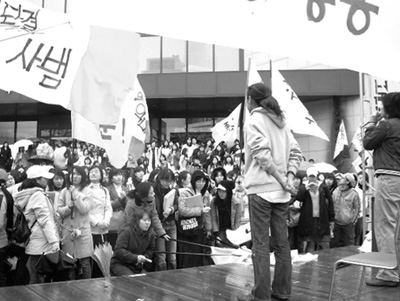
The students claimed that the universities should give back part of the students' money, expand financial support methods, and freeze tuition at 2005 levels. Such protests against universities, as well as the government whose market-oriented "eo-liberal" approach to education authorizes schools to raise tuition every year, are common these days. In addition, it is not only students but also professors and some political groups, such as members from the Democratic Labor Party, who are raising their voice against increased tuition and the competition-driven policies toward education in South Korea.
Yet, in neighboring countries, a slightly different attitude prevails. In Japan, though tuition is roughly equal to that of Korea, student activism is minimal, while in China, activism is nonexistent and fees are much lower.
In South Korea, the annual tuition at most universities is about 6,000,000 won. Usually Medicine, Pharmacy, and Music departments have the highest tuition fees. Though student councils do not have an influence on fixing the tuition rates, the Student Government Associations (SGAs) in a number of universities are active in protesting against what they see as unfair tuition increases. For example, the president of the SGA at Ewha Womans University shaved her head in order to show her resilience towards raised tuition fees on March 16. In addition, the student body of the Kyungsang University initiated a candlelight demonstration within the university to protest against the same matter on the same date. Usually, Korean students don't earn their own tuition fees because tuition is so much higher than their earnings from part-time jobs. Thus, it is usually the parents who are responsible to pay for their children's education; though in less privileged families, students do receive scholarships from the government, corporations, public organizations and the schools they attend.
In comparison, in Japan, the average tuition fee is about 860,000 yen (approximately 7,160,000 won)-not much different from that of South Korea. Usually, the science majors have to pay more because of laboratory fees.
Moreover in contrast to Korea, students have not actively protested against tuition increase since the 70s. In fact, few university departments have student governments at all. In Waseda University, for example, the only student government which is approved by the school is in the Social Science Department. Student activism is limited to passing out leaflets and sending occasional letters to the university's administrative offices. Parallel to the situation in South Korea, Japanese students cannot earn enough to pay for the tuition fee by doing part-time jobs. The Japanese government does not usually pay tuition for students, but supports them financially by providing about 120,000 yen (about 1,000,000 won) on a monthly basis to those in need. Corporations such as Sony and Matsushita are known to provide financial support for students and it is not always the students with the highest GPAs that receive this, but students with special talents or exceptional needs as well.
In China, the average tuition is about 5,500 yuan (about 670,000 won), but the most expensive departments are Software Engineering and Design majors which are approximately 12,000 yuan (approximately 1,460.000 won) per year. These departments are more expensive than others because no government subsidy supports these new majors, which started less than ten years ago. In the case of other departments, education is largely funded by the government. Most students in China accept the tuition rates, which are decided by the Ministry of Education of the Central Government and consider it affordable.
Around half of the undergraduate students are funded by their parents and the other half receive scholarship from the university or from their departments. In Tsinghua University, around one third of the undergraduate students receive scholarships or other assistance from the university. Like in Korea, it is usually students with high GPAs and underprivileged circumstances that receive the scholarships.
임리영 기자
rhiealways@ewhain.net

